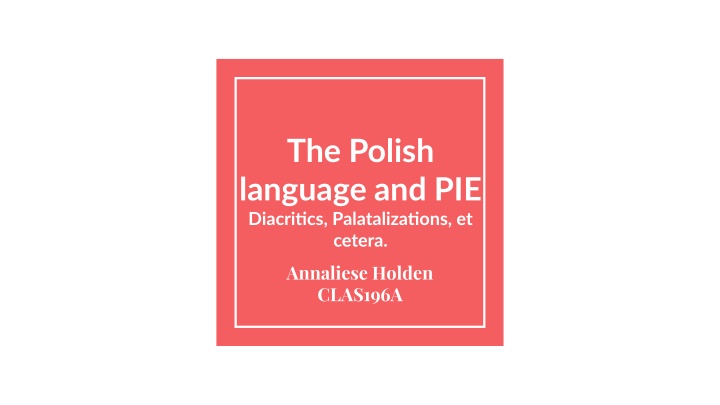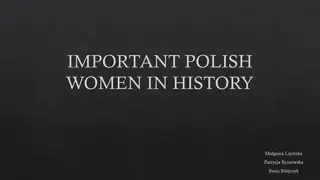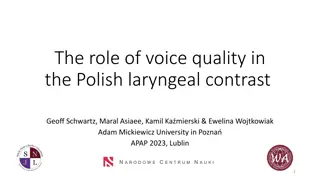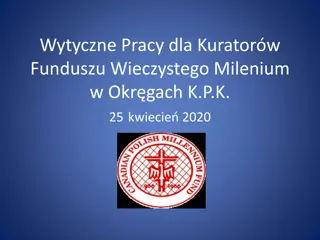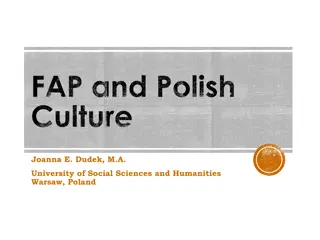Exploring the Unique Features of the Polish Language
Polish, a West Slavic language, boasts a distinctive alphabet with diacritics like ogonek and kreska. Nasalized vowels and palatal consonants set Polish apart, showcasing its rich linguistic heritage from Proto-Balto-Slavic to PIE roots.
Download Presentation

Please find below an Image/Link to download the presentation.
The content on the website is provided AS IS for your information and personal use only. It may not be sold, licensed, or shared on other websites without obtaining consent from the author.If you encounter any issues during the download, it is possible that the publisher has removed the file from their server.
You are allowed to download the files provided on this website for personal or commercial use, subject to the condition that they are used lawfully. All files are the property of their respective owners.
The content on the website is provided AS IS for your information and personal use only. It may not be sold, licensed, or shared on other websites without obtaining consent from the author.
E N D
Presentation Transcript
The Polish language and PIE Diacritics, Palatalizations, et cetera. Annaliese Holden CLAS196A
A little background Polish is a modern language, in Fortson s Balto-Slavic chapter, it is identified as West Slavic. -Of the Slavic languages, Polish is the third- largest spoken language. (Fortson 18.48) -Polish descends from Proto-Balto-Slavic, which is the middleman from PIE (PIE -> Proto-Balto-Slavic (PBS) -> Polish)
The Polish alphabet and its differences Polish is written in the standard Latin alphabet, with a few exceptions. The diacritical exceptions are , , , , , , , , . I will explain the diacritics and how they originated in an upcoming slide. Some of these are nasalized vowels, and some are palatal consonants, both of which the Latin alphabet was not equipped to describe. The letters q, v, and x are not considered part of the alphabet either, only in words that are borrowed from other languages. A q sound would be made with the consonant pair kw (example: qualification vs. kwalifikacje) A v sound is simply replaced, made by the letter w (example: Warszawa, the capital city) Pronounced: var-SHAV-ah A x sound is replicated by ks [example: tekst vs. text (message)]
The ogonek and nasalized vowels This diacritical mark literally translates to little tail from Polish. You can see it in the letters and . is a nasalized e , while is a nasalized o . - is not a nasalized a because of a vowel shift, evolved in turn from the merged nasal * and * of Late Proto-Slavic. - I know what you re thinking, nasalized vowels? Yes, Polish has these! The nasal usually assimilates with the following consonant. is pronounced like rendez-vous, and like owh (this is the closest I can transliterate a nasal, it ultimately depends on the following letter!) - PIE sequences of *an ,*in, *en, or *im, *em, *om would become and . - Examples of descent from PIE: * ombho- tooth -> Polish z b , * hans- goose -> Polish g - According to Fortson, Polish is an exception to the Slavic languages tendencies to denasalize. (Fortson 18.32) Pl-mog .ogg pronounces mog , the 1st person singular of to be able to - Here are some links to Wikipedia pronunciations: Pl-m .ogg pronounces m , the word for husband
The kreska and palatal consonants Found over , , , , and through the letter in . , , , are palatal consonants, with their own unique sounds separate from their unaccented counterparts. Because Balto Slavic is a satem branch, all plain velars *k, *g, *gh, and labiovelars *kw, *gw, *gwh became the plain velars k and g. (Fortson 18.4) Palatal consonants are HUGELY important in Balto-Slavic languages and occurred in three movements. (Fortson 18.25) - The First Palatalization changed the velars k, g, x before *i or a front vowel to , (later, ), . Example: PBS *slug-iti to serve -> Polish s u y The Second Palatalization changed k, g, x before Example: PIE *kwoi-neh2 price -> PBS *k na -> Polish cena The Third Palatalization changed k, g, x before most vowels and after i or . However, this step is far more sporadic, according to Fortson. It does not appear to apply to Polish as much as other Slavic languages. Example: PIE *k r d-iko- -> PBS *sridiko -> Polish serduszko - -
Palatal consonants cont. English equivalent: cheer English equivalent: jeep English equivalent: she English equivalent: azure English equivalent: canyon Examples: Mierzy to disgust Dziadzio grandfather Dzi today d (city in Poland) Dania dishes
The letter I mentioned previously that the Polish letter w makes the sound of a v so what makes the sound of a w? The answer is , or L with stroke. It was formerly used to distinguish velarized ( dark ) L from clear L. Now, it resembles the English w (water) Example: PIE *(s)mal small - -> PBS *malu -> Polish ma y. So, it can be seen that descending from PIE, continued to just be a version of L. However, from Wikipedia: In modern Polish, is normally pronounced /w/ (exactly as w in English as a consonant, as in wet). This pronunciation first appeared among Polish lower classes in the 16th century. It was considered an uncultured accent by the upper classes (who pronounced as / /) until the mid-20th century when this distinction gradually began to fade. ( . Wikipedia, Wikimedia Foundation, 20 Jan. 2020, en.wikipedia.org/wiki/ .) Fun fact: Even today in Poland, you will occasionally encounter older folk who pronounce the velar L as / /, similar to how some older-age English speakers pronounce an h in front of words beginning with wh , like in Old English ( hwhat , hwhere , hwhite )
Examples of PIE roots to Polish Some PIE roots that we are familiar with carried very clearly through PBS to Polish, for example: PIE *d m house -> Polish dom PIE *wl kwos wolf -> Polish wilk PIE *w dr water -> Polish woda
Examples of PIE roots to Polish, cont. Some roots carried over, although not as clearly. For example: Brother (fun excuse to call your brother a brat) PIE *b r h t r -> Proto-Balto-Slavic *br t -> Polish brat (Wiktionary) How did this change occur? Let s begin with b . - Balto-Slavic merged aspirated and unaspirated voice stops, so b simply became b, leading to *br h t r. (Fortson 18.3) Laryngeals disappear, but in the first syllable after a vowel, become *a, leading br h t r to brat r. (Fortson 18.13) In Slavic, the r became the hard sign er goljam , . This does not exist in Polish, so the hard sign simply dropped and became Polish brat. (Wiki: Hard sign) - -
Exercises! 1. Based off the information about the palatalized consonants and nasalized vowels, what became of the following PIE letters? a. Velarized L b. Nasalized o c. *g before an *i or a front vowel 2. happened to laryngeals in the descent from PIE, as well as the collapse of velars and labiovelars; Based off of the information of the PIE roots to Polish slides, and what What do you think the outcome of *h3 kws eye is in Polish?
Exercise answers! 1. a. Velarized L became , or L with stroke b. Nasalized o became , or a with ogonek c. *g before *i or a front vowel became or (First Palatalization!) 2. The outcome of *h3 kws eye in Polish is oko . (Also would accept okos ) Remember that laryngeals disappear, and because *h3precedes the vowel, does not color to *a, leaving *okwos. The labiovelar kwcollapses into k, leaving *okos. I have no explanation for the dropped *s, however, one can clearly ascertain that the two roots are related from the steps taken above.
Questions? Comments? Anyone feel confident enough to try and pronounce some Polish words? :)
Citations Images: References: . Wikipedia, Wikimedia Foundation, 20 Mar. 2020, en.wikipedia.org/wiki/ . Https://Crazypolishguy.files.wordpress.com/2015/01/Polish-Letters.gif. Https://Crazypolishguy.files.wordpress.com/2015/01/Polish-Letters.gif. Https://Upload.wikimedia.org/Wikipedia/Commons/6/67/Slavic_languages.Jpg. Https://Upload.wikimedia.org/Wikipedia/Commons/6/67/Slavic_languages.Jpg, Wikimedia. . Wikipedia, Wikimedia Foundation, 17 Feb. 2020, en.wikipedia.org/wiki/ . Fortson, Benjamin W. Indo-European Language and Culture: an Introduction. 2nd ed., Wiley-Blackwell, 2010. . Wikipedia, Wikimedia Foundation, 20 Jan. 2020, en.wikipedia.org/wiki/ . Ma y. Wiktionary, en.wiktionary.org/wiki/ma y#Polish. Ogonek. Wikipedia, Wikimedia Foundation, 22 Feb. 2020, en.wikipedia.org/wiki/Ogonek. Polish Orthography. Wikipedia, Wikimedia Foundation, 9 Nov. 2019, en.wikipedia.org/wiki/Polish_orthography. Proto-Slavic. Wikipedia, Wikimedia Foundation, 7 Apr. 2020, en.wikipedia.org/wiki/Proto-Slavic.
